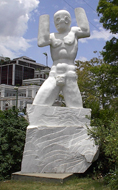Going Back to Zimbabwe and Homeland, Ethiopia - Jan/Feb 2007
- Details
- Created: Tuesday, 02 January 2007 02:52
Editor: Daniel currently lives with his wife, Jeanette in Des Moines, Washington. He has been a member of NWSSA since July, 2000.
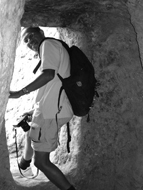
From December 26, 2005 to January 20, 2006, my wife and I traveled to Zimbabwe and Ethiopia.
As soon as our flight landed in Harare, Zimbabwe, we were greeted by beautiful works of art, both inside and outside the airport. We immediately knew we were in sculpture heaven. On the ride from the airport to the city, I was amazed to see the many carvers working under shade trees on the side of the road.
In fact, I began to believe that we might find carvers under every tree. Most of the carvers are members of the Shona tribe in Zimbabwe. These beautiful people are known for their wood and stone carvings. Since opal and serpentine (also called “spring stone”) are abundant in Zimbabwe, most of the works are carved out of these two stones. As you know, opal is a lot softer than spring stone. Yet most of them do not use any power tools. Even their chisels are handmade. I was saddened to see that none of them wore safety gear for protection.
The Shona carvers I met explained that they inherited their carving skill from their forefathers. Most carvers intend and believe they have a responsibility to pass
on the art to the next generation. This may explain why we found the same themes, even identical sculptures at different locations. Regardless, we did learn so much in that short time and we loved it. We were fortunate to purchase some small sculptures from the carvers we met in Harare and at Victoria Falls. Unfortunately, our travels prevented us from buying larger pieces.
Though we only had one week in Zimbabwe, we left with many beautiful memories of both the people we met and the country and its art.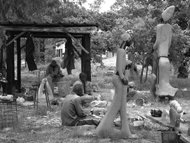
The main reason for our trip to Africa was to visit Ethiopia, my birthplace, which I hadn’t seen for more than 20 years. Though Ethiopia is known by most Americans for the images broadcast during the famine of the 1980s, Ethiopia is a country of generous people who cherish their history and culture.
There is no question that Ethiopia is one of the poorest nations in the world; at the same time, she has a rich history that goes back 2,000 years.
Many Ethiopians believe that the Ark of the Covenant (you may recall the movie Indiana Jones and the journey to find the Ark of the Covenant) has been and remains in Ethiopia. Ethiopians believe without a doubt that the Ark is in a temple in the city of Axum, in the northern part of Ethiopia. The temple is guarded day and night, and no one is allowed to go inside. We visited the temple grounds and went as far as we were allowed. Nearby, we also visited the ruins of what was believed to have been the palace and bath of the Queen of Sheba.
In the center of the city of Axum, we visited the site of huge obelisks, each carved and erected out of one solid granite rock. It was mind boggling to think that these rocks have been standing for centuries. I cannot help but wonder how each obelisk had been carved perfectly out of one rock, during a time before the existence of power tools. Somehow, even without cranes, they managed to erect these huge monuments. In my opinion, the Axum obelisks should be one of the “seven wonders of the world.” Editor’s note: web search “Axum obelisk” or go to: www.ethioembassy.org.uk/tourism/tourism.htm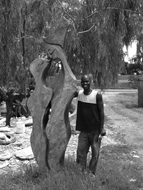
Another historical place not far from Axum is Lalibela. This small city, named for King Lalibela, is very fascinating. The main attraction in the city is seven churches that were each carved out of one rock, and connected by tunnels. These churches were completed in 1103 and are one of the most visited attractions in Ethiopia, especially on holidays. As I was visiting the rock-hewn churches of Lalibela, I was so puzzled and kept on wondering about the contrast between the modern Ethiopia and the innovative Ethiopia of ancient times. I believe the Ethiopians who made these churches were way ahead of their time. The way the buildings are constructed with perfect angles and corners—and from one rock—is astonishing. The paintings on the walls, relief style figures carved out of the same rock. I was so impressed. All I could say was, “WOW!” The rock used was granite, and as you know, this rock is not as soft as soapstone or sandstone. It is so amazing to see such wonderful work was completed in 23 years without any modern tools. The best way to understand our amazement is to visit Lalibela and experience it firsthand.
Another place we visited was Gondar, the ancient capital city of Ethiopia. Gondar also has a rich history and is known for Fassil’s Castle, which was completed in 1623. Nearby, we went to visit the town where the black Jews of Ethiopia (or Falasha) used to live. As you might recall, most of the Falasha were airlifted to Israel in 1989. Nevertheless, their synagogue and their handicrafts are still there. Another notable experience we had was visiting Lake Tana, the source of the Nile River.
Every place we went, we were touched by the generosity and kindness of the many people we met. Some were close relatives I hadn’t seen for more than 20 years, and others were friends we made on our journey to the historical cities I have mentioned or in the ever-changing capital city of Addis Ababa.
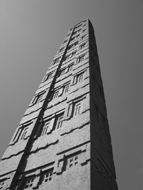
We brought back with us many memories of our nearly month-long journey to Zimbabwe and Ethiopia. If you decide to visit either of these countries, we will be more than happy to assist you in any way we can. You may contact us by phone: 206-592-0458 or by email at: This email address is being protected from spambots. You need JavaScript enabled to view it.


